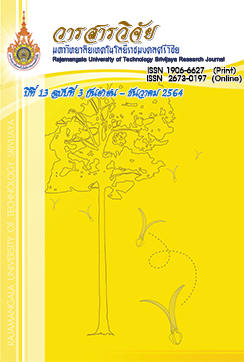Effects of Extracting Conditions of Pigmented Rice Bran on Anthocyanin and Antioxidant Activity and Its Storage Stability
Main Article Content
บทคัดย่อ
งานวิจัยครั้งนี้มีวัตถุประสงค์เพื่อศึกษาผลของสายพันธุ์รำข้าวที่มีสี (PRB) และสภาวะที่เหมาะสม
ในการสกัดปริมาณสารประกอบฟีนอลิก (TPC), ปริมาณแอนโทไซยานิน (TAC), ความสามารถในการต้าน
ออกซิเดชั่น (DPPH) และศึกษาความคงตัวในระหว่างการเก็บรักษา โดยในการทดลองจะศึกษาสายพันธุ์ของข้าว 3 สายพันธุ์, ขนาดอนุภาคของรำข้าว 3 ขนาด, สภาวะในการสกัดแบบเขย่าและไม่เขย่า, ตัวทำละลายในการสกัด
6 รูปแบบ, เวลาและอุณหภูมิในการสกัด 4 แบบ จากผลการทดลองพบว่า สายพันธุ์ที่เหมาะสมที่สุดคือ ข้าวหอมนิล ที่มีขนาดอนุภาค 60 เมซ สกัดในสภาวะที่มีการเขย่า ด้วยตัวทำละลาย 2%ของสารละลายซิตริก โดยทำการสกัดเป็นเวลา 3 ชั่วโมง ที่อุณหภูมิ 40 องศาเซลเซียส โดยมีค่า TPC, TAC และ ความสามารถในการต้านออกซิเดชั่น ด้วยวิธี DPPH มีค่าเท่ากับ 320 มิลลิกรัมแกลลิค (GAE)/100กรัม, 238.02 มิลลิกรัมไซยานิดิน /100กรัม และ 87.09% ตามลำดับ นอกจากนั้นในการศึกษาความคงตัวในระหว่างการเก็บรักษาที่ 3 อุณหภูมิ ในช่วงเวลา 0-63 วันโดยเก็บในสภาวะที่มีแสงและไม่มีแสงจากการทดลองพบว่า ปริมาณ TPC, TAC และกิจกรรมการต้านอนุมูลอิสระด้วยวิธี DPPH จะมีค่าลดลงเมื่อเวลาในการเก็บนานขึ้นและเก็บในสภาวะที่มีแสง ดังนั้น ในการสกัดแอนโทไซยานินจากรำข้าวที่มีสีสามารถนำมาใช้เป็นสารออกฤทธิ์ชีวภาพในอาหารและในอุตสาหกรรมเครื่องดื่มได้ แต่อย่างไรก็ตาม ควรเก็บสารสกัดไว้ในสภาวะที่เหมาะสมก่อนนำไปใช้เพื่อให้มีความคงตัวและเกิดประโยชน์สูงสุด
Article Details
เนื้อหาและข้อมูลในบทความที่ลงตีพิมพ์ในวารสารวิจัยมหาวิทยาลัยเทคโนโลยีราชมงคลศรีวิชัย ถือเป็นข้อคิดเห็นและความรับผิดชอบของผู้เขียนบทความโดยตรง ซึ่งกองบรรณาธิการวารสารไม่จำเป็น ต้องเห็นด้วย หรือร่วมรับผิดชอบใดๆ
บทความ ข้อมูล เนื้อหา รูปภาพฯลฯ ที่ได้รับการตีพิมพ์ในวารสารวิจัย มหาวิทยาลัยเทคโนโลยีราชมงคลศรีวิชัย ถือเป็นลิขสิทธ์ของวารสารวิจัย มหาวิทยาลัยเทคโนโลยีราชมงคลศรีวิชัย หากบุคคลหรือหน่วยงานใดต้องการนำทั้งหมดหรือส่วนหนึ่งส่วนใดไปเผยแพร่ต่อหรือเพื่อการกระทำการใดๆจะต้องได้รับอนุญาตเป็นลายลักษ์อักษรจากวารสาร มหาวิทยาลัยเทคโนโลยีราชมงคลศรีวิชัยก่อนเท่านั้น
References
Ahuja, U., Ahuja, S.C., Chaudhary, N. and Thakrar, R. 2007. Red Rices-Past, Present, and Future. Asian Agri-History 11: 291-304.
Fera, A., Galih, N.A., Arini, M., Alia, N.F., Sisca, U. and Mimiek, M. 2013. Extraction and stability test of anthocyanin from Buni fruits (Antidesma bunius L) as an alternative natural and safe food colorants. Journal of Food and Pharmaceutical Science 1: 49-53.
Giusti, M.M. and Wrolstad, R.E. 2001. Characterization and measurement of anthocyanins by UV-Vis spectroscopy, pp.26-29. In Wiley. Current protocols in Food Analytical Chemistry Unit F1.2. John Wiley & Sons, Inc., United States.
Hiba, N.R., Nada, El, D., Zeina H., Nadia, B., Eugene, V., Richard, G.M. and Nicolas, L. 2014. Extraction of total phenolic compounds, flavonoids, anthocyanins and tannins from grape byproducts by response surface methodology. Influence of solid-liquid ratio, particle size, time, temperature and solvent mixtures on the optimization process. Food and Nutrition Sciences 5: 397-409.
Jing, P. and Giusti, M.M. 2007. Effects of extraction conditions on improving the yield and quality of an anthocyanin-rich purple corn (Zea mays L.) color extract. Journal of Food Science 72(7): 363-368.
Kannan, A., Hettiarachchy, N.S., Lay, J.O. and R. Liyanage. 2010. Human cancer cell proliferation inhibition by a pentapeptide isolated and characterized from rice bran. Peptides 31: 1629-1634.
Laleh, G.H., Frydoonfar, H., Heidary, R., Jameei, R. and Zare, S. 2006. The effect of light, temperature, pH and species on stability of anthocyanin pigments in four Berberis species. Pakistan Journal of Nutrition 5: 90-92.
Maier, T., Fromm, M., Schieber, A., Kammerer, D.R. and Carle, R. 2009. Process and storage stability of anthocyanins and non-anthocyanin phenolics in pectin and gelatin gels enriched with grape pomace extracts. European Food Research and Technology 229: 949-960.
Maisuthisakul, P. and Changchub, L. 2014. Effect of extraction on phenolic antioxidant of different Thai rice (Oryza sativa L.) genotypes. International Journal Food Properties 17(4): 855-865.
Masuda, T., Yonemori, S., Oyama, Y., Takeda, Y., Tanaka, T. and Andoh, T. 1999. Evaluation of the antioxidant activity of environmental plants: activity of the leaf extracts from seashore plants. Journal of Agricultural and Food Chem 47: 1749-175.
Oki, T., Masuda, M., Kobayash, M., Nishiba, Y., Furuta, S., Suda, I and Sato, T. 2002. Polymeric procyanidins as radical-scavenging components in red-hulled rice. Journal of Agricultural and Food Chemistry 50(26): 7524-7529.
Patrauanu, O.A., Lazer, L., Popa, V.I. and Volf, I. 2019. Influence of particle size and size distribution on kinetic mechanism of spruce bark polyphenols extraction. Cellulose Chemistry and Technology 53: 71-78.
Palamidis, N and Markakis, P. 1975. Stability of grape anthocyanin in a carbonated beverage. Journal of Food Science 40: 1047-1048.
Shao, Y., Xu, F., Sun, X., Bao, J. and Beta, T. 2014. Identification and quantification of phenolic acids and anthocyanins as antioxidants in bran, embryo and endosperm of white, red and black rice kernels (Oryza sativa L.). Journal of Cereal Science 59:211-218.
Song, J., Smart, R., Wang, H., Dambergs, B., Sparrow, A. and Qian, M.C. 2015. Effect of grape bunch sunlight exposure and UV radiation on phenolics and volatile composition of Vitis vinifera L. cv. Pinot noir wine. Food Chemistry 173: 424-431.
Sukhapat, N., Ungphaiboon, S., Itharat, A., Puripattanavong, J. and Pinsuwan, S. 2004. Influence of pH on antioxidant activity of roselle (Hibiscus sabdariffa L.) extract in aqueous solution, p184. In The 10th World Congress on Clinical Nutrition: Nutrition in the Next Decade: Nutraceutical/ Functional Food: Product Performance in Health, Disease and Safety, 30 Nov-3 Dec., 2004. Organized by PSU, INC and BIOTEC, Phuket.
Yoshida, H., Tomiyama, Y. and Mizushina, Y. 2010. Lipid components, fatty acids and triacylglycerol molecular species of black and red rice. Journal of Food Chemistry 123: 210-215.

